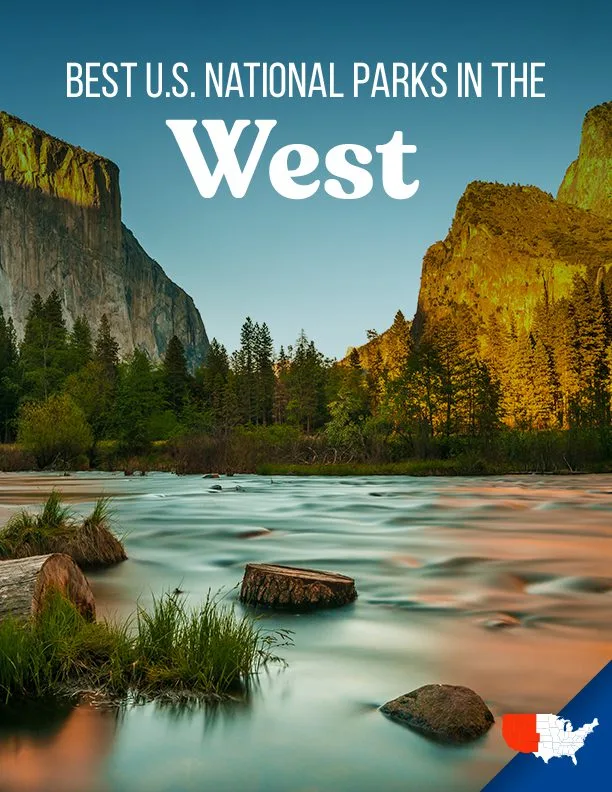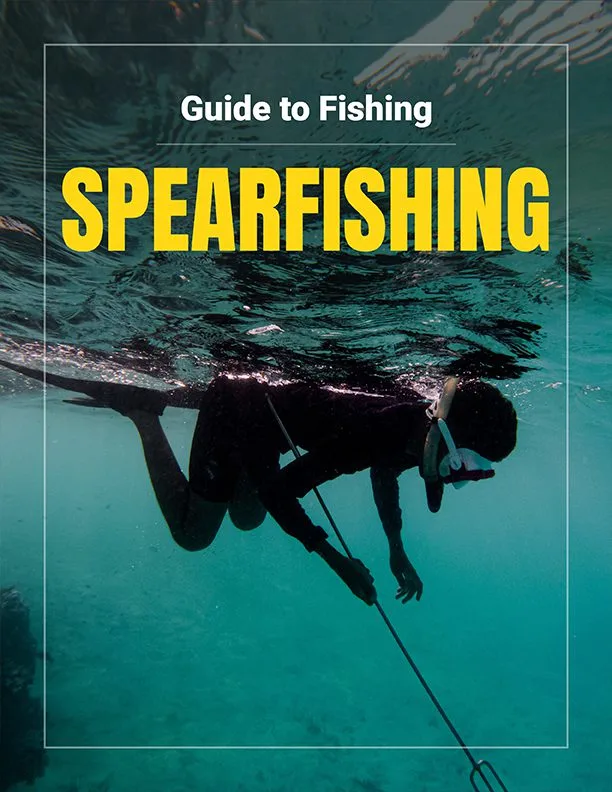Best U.S. National Parks in the South
Best U.S. National Parks in the South
We are privately owned and not affiliated with the government in any way or form.

Introduction
When you think of the South, it calls to mind images of country life, pickup trucks, barbecue and fried chicken. However, the region might surprise you with its rich history and cultural diversity. The southern U.S. includes many states, including such distinct ones as Florida, Texas, Louisiana and Virginia. It’s full of music, culture and tradition. Many famous American authors, like Harper Lee, William Faulkner and Flannery O’Connor, were born in the South. Rural areas, including plantations are an easily recognizable, popular backdrop for American and African-American literature. The influence of events like the Civil War and the Civil Rights Movement have shaped the cultural and social landscape — past and present.
From Nashville to New Orleans, music is another central influencer to the Southern way of life. Memphis, Tennessee was the birthplace of blues, jazz and rock ‘n roll and Nashville is known for being the epicenter of country music. It’s also known for home cooking and some of the best food in the country: biscuits, okra, collards and stick-to-your-ribs barbecue. Come for the food, stay for the fun.
Virginia, North Carolina, Georgia and South Carolina were the heart of the antebellum south, with plantations, slave markets, civil rights demonstrations and stops along the Underground Railroad. Louisiana has its own unique Cajun culture and is the home of New Orleans with its Mardi Gras and jazz. Texas, while in the south, has more of the character of the west with cowboys and desert. Don’t forget Florida, the home of Disney World, one of the most-visited theme parks and picturesque beaches that draw tourists in droves. Away from the crowded theme parks and busy beaches, this region has many national parks that offer a wide range of ecosystems and natural beauty, from the Everglades wetlands to the spectacular coral reefs of the Dry Tortugas, teeming with marine life.
South Atlantic Division
Everglades National Park
Florida
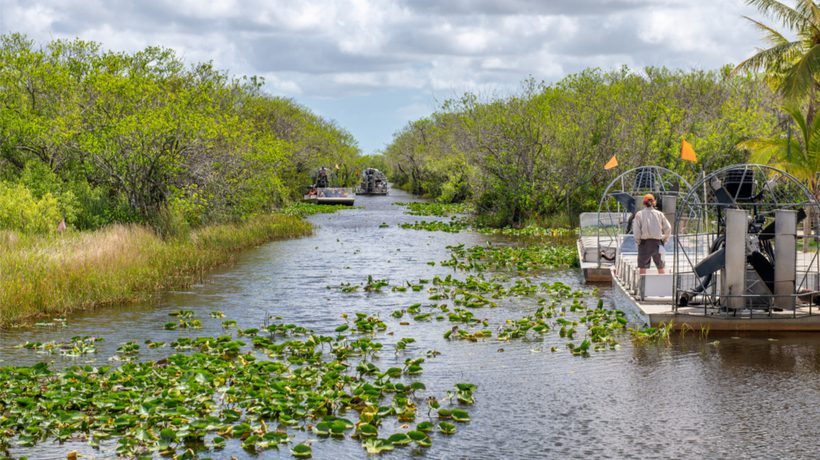
Everglades National Park is 1.5 million acres of protected wetland, covering a large portion of southern Florida. You can see many endangered species in the Everglades, such as the American crocodile, manatees and the elusive Florida panther. The wetland is so essential that it is protected through many global conservation entities and treated as an international treasure. Embark on a thrilling airboat ride and watch the Everglades fly by, while spotting herons, alligators and peregrine falcons. Or paddle down the waterways in a canoe or kayak. You may even catch sight of the manatees or dolphins that live here! Take in the view from the 65-foot observation tower at Shark Valley or watch the spectacular sunset from Flamingo, the southernmost point in the mainland.
The park is also a world-class destination for anglers, with over 250 species of fish. While navigating the waters here can be a little tricky, it is well worth it. Freshwater and saltwater fishing here require a permit, but there are snapper, redfish, bass and sea trout in abundance. Guided fishing, walking and boat tours are available including the wonderful Florida Bay Boat Tour out of Flamingo, where you can see and learn about the birds and marine life of the area including manatees and dolphins while sailing on a catamaran and catching the sunset. Explore more on the Shark Valley tram tour or one of the three airboat tours in the park. Birdwatching trips, kayak and canoe tours, photography tours, fishing guides and eco boat tours are also offered for a majority of the year and are sure to immerse you in the “Sea of Grass,” where you can learn more about the natural systems at work. If you prefer to explore on your own, bicycle, canoe and kayak rentals are available in the park. You can bike down the 15-mile Shark Valley loop, canoe down the 99-mile Wilderness Waterway (or a portion of it), or walk the Anhinga Trail, a popular boardwalk trail and one of the best places to spot alligators.
Plan ahead and save time by picking where you wish to enter the park, as the three entrances are hours apart by car. Enter through Shark Valley in Miami, come into the Gulf Coast Visitor Center in Everglades City or through the Royal Palm main entrance in Homestead, which takes you into the heart of the Everglades and offers some of the best trails to view the wildlife. The Everglades has two seasons: the dry (November to March) and the wet (April to November). The dry season is the most popular time to visit, as that is when the animals are most active and seen. You may wish to stay overnight at one of the front country or backcountry camping sites. More convenient drive-in camping sites are available for tent and RV camping. You can also take your boat to one of the secluded ground or beach sites off-the-beaten-path after picking up a backcountry permit at one of the visitor centers.
The park is home to all kinds of unique flora and fauna, including some threatened and endangered species. While the Everglades may be infamous for pesky mosquitoes, there is also beauty here: herons, turtles, marsh rabbits, river otters and white-tailed deer. Less pleasant and sometimes dangerous species like alligators, crocodiles, ticks, whip scorpions and spiders are also supported by the various marine and coastal lowlands ecosystems within the park, so be sure to wear protective clothing and follow all rules and ranger instructions. Be prepared for insects and Florida sunshine by wearing sunscreen, long sleeves and pants. Bringing plenty of insect repellant is highly recommended, especially in the summertime. If you visit during the wet season, some services, like guided tours, may not be offered during this time. An entrance fee of $25 per car is active for seven days after purchasing.
Dry Tortugas National Park
Florida

The Dry Tortugas National Park takes some effort getting to, since you can only get there by boat or seaplane, but it is worth it. Located 70 miles west of Key West at the extreme southernmost part of the continental United States, Dry Tortugas consists of a chain of seven small islands, surrounded by pristine, cobalt and turquoise tropical waters. In fact, most of the park’s 100 square miles is under water, where coral reefs shelter sea turtles, eels, reef fish in every color of the rainbow, lobsters, squid, Goliath groupers and sharks. In addition to the natural coral reefs, there are plenty of shipwrecks that have become habitats for marine life. When snorkeling, swimming and diving in the warm, relatively shallow water, remember that the animals and shipwrecks are all protected, so spearfishing, shell collecting and disturbing anything below the water’s surface are prohibited. The ferry and seaplane provide snorkel gear, but cannot accommodate dive canisters, so if you plan on diving, you will need to bring your equipment on your own boat or charter vessel. There are a variety of snorkeling and diving sites, including the structures on Garden Key like the moat wall, the Little Africa Coral Reef on the north side of Loggerhead Key and the Pulaski Shoals area in the eastern part of the park, where you can find plenty of shipwrecks. For adventuresome, experienced divers, go out to beyond the boundary buoys at Pulaski Shoals where there is deep water populated by a variety of sharks, eagle rays and turtles. If you do, be mindful of the strong currents. Always snorkel or dive with a buddy.
Both the Key West Seaplane Charters and the Yankee Freedom Ferry offer narrated tours of the natural resources, animal life and history of the park or you can download a self-guided tour. Garden Key boasts Fort Jefferson, a 19th century fort that protected the shipping lanes from the Gulf Coast to the Eastern Seaboard. Loggerhead Key has a lighthouse and an abundance of wildlife to see. However, there is no public transportation to Loggerhead Key; you will need to get there either by private boat or on your own kayak or canoe. If you are a bird watcher, you must go to Bush Key, where you can find birds that cannot be found anywhere else in the continental US. Bush Key is closed from February to September when tens of thousands of sooty terns and brown noddies use it for breeding. Talk a relaxing stroll on the 1-mile trail around Bush Key to take in the natural beauty. Swim and sunbathe on the clean and uncrowded beaches on Garden Key and Loggerhead Key, with snorkeling just a few yards out. The nights in Dry Tortugas are gorgeous, since it is so far from civilization. Visitors will be amazed at the number of stars they can see, and for a really unique experience, do a night swim near the moat wall. During the night, you can get much closer to the fish that you would during the day, and the proximity to land and shallow waters make it safe even for accompanied children.
When you are done exploring the park, head back to Key West. There are plenty of things to do there including touring Ernest Hemingway’s house which is populated by hundreds of descendents of his cats, take a picture at the Southernmost Point of the continental US, rent a bike or scooter or catch the street performers at Mallory Square.
Chattahoochee River National Recreation Area
Georgia
Sometimes peaceful and calm, sometimes wild and rushing, there is something special about the beauty of a river. The Chattahoochee is a perfect example of this unique beauty. Its 48 miles of crystal clear water is surrounded by a lush green forest. The river is an important resource for food and water for people, creatures and plant life alike, who have depended on it for survival for centuries. Historically, the Chattahoochee also provided transportation for the goods from the mills and factories that once thrived here. The national parks system now sets apart this area for the public to enjoy recreational activities like fishing, hiking, boating and tubing. Start your visit by stopping by the Hewlett Lodge Visitor Center in Sandy Springs, Georgia where you can learn about the park, get a map and obtain a Park Pass or America the Beautiful Pass. In addition to driving your own vehicle to the area, there are a variety of ways to get there via public transportation.
The river is refreshingly cool all year long, perfect for boating and floating. The plentiful trout, catfish and bass make it an ideal place to cast your line. Picnic on the shore or cycle through the wooded forests. The seven miles for cycling are a great way to take in the scenery. If you’re a boater, then the river is open from sunrise to sunset. The waters of the Chattahoochee are usually peaceful and calm, but there are occasional small torrents, rocky shoals and small rapids. Bringing thick, rubber-soled shoes to navigate the jagged rocks and slippery surfaces along the river is wise. When visiting the park, don’t miss out on tubing. Bring your friends along for a fun float along the river. You can rent any canoes, kayaks, tubes or rafts from one of the authorized outfitters. Travel down the river and take the provided shuttle back to your car. Note that you’re required to wear a personal floatation device for added safety.
During your relaxing trip downriver, you may spot some of the over 200 bird species, like the beautiful blue heron, soaring overhead or wading in the shallow banks. Migrating birds love to visit the Chattahoochee but many others, like the blue jay, Carolina chickadee and the Northern Cardinal, call the area home. Mammals like rabbits and white-tailed deer drink from the waters and frolic in the forests. When the sun sets over the Chattahoochee, the magic continues as frogs start croaking and the crickets begin their chirping. Under the dark cover of night, owls and bats come out of their hiding places for a late-night snack. Over 800 species of plants provide plenty of food and shelter for the wildlife. Hibiscus, scarlet sumacs and fragrant hyssop are among the remarkable blossoming plants here. Wildflowers bloom in almost every season. Catch the peak of fall color from mid-October through early November.
If you plan on fishing during your visit, then remember anglers over 16 must have a Georgia fishing license. Check the park’s website or inquire with a park ranger to learn more about the trout-specific fishing regulations in this area. If you’d benefit from a little more hands-on guidance, authorized fishing guides and tours are available. Tours and equipment rentals are additional add-ons, but admission to the park is $5 a day or you can use your America the Beautiful Pass to begin your adventure on the Chattahoochee.
Congaree National Park
South Carolina
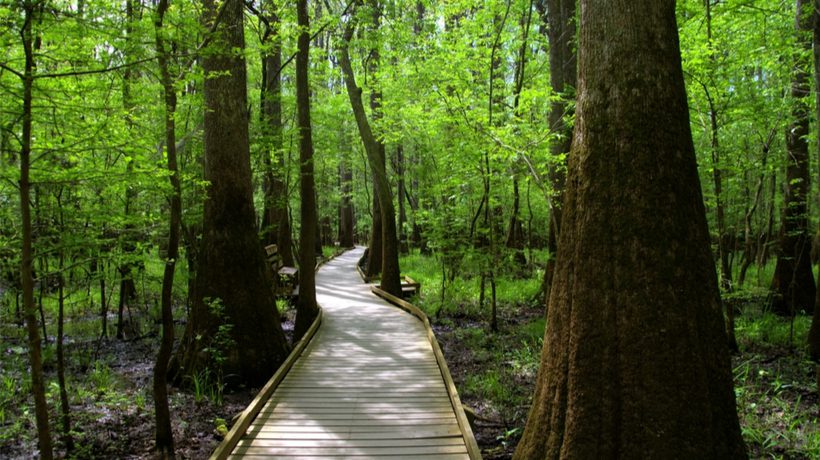
Congaree National Park is in central South Carolina, just 18 miles southeast of Columbia and preserves the largest stand of old growth bottomland hardwood forest in the United States. It features some of the tallest trees in the eastern US and shelters a variety of wildlife. The untouched, organic ecosystem here is exactly what you may picture when you imagine a secluded national park getaway. The waters here are kept purposefully peaceful and motorized boats are not allowed. The absence of noise pollution allows you to hear the sounds of nature without distraction. From the songs of the birds in the trees to the whoosh of your paddle slicing through the water, this is a place for relaxation and rejuvenation. There is life all around and you are part of it.
There are more than 25 miles of hiking trails and an easily accessible stretch of boardwalk. Hiking is open year-round. A short walk along the boardwalk may satisfy your cravings for the great outdoors, but for those who need more, go off the beaten path and explore the backcountry. If you’re a birdwatcher, bring your binoculars since there are plenty of bird species living in the tallest deciduous forest in America including several species of hawk, golden eagles, storks, cuckoos, goldfinches and hummingbirds. Most Saturdays the park offers ranger-guided programs to learn more about the park and the natural processes at work here.
Paddle down a stretch of the beautiful 50-mile Congaree River Blue Trail. Take your canoe or kayak to enjoy the solitude of the hardwood forests or take to your feet to get a closer look at this South Carolina national park. Bring your rod, state fishing license and fishing gear for recreational fishing in the meandering river or wade out to one of the shallow sandbars. Paddle on the 15-mile Cedar Creek Canoe Trail, which takes you through a primeval old growth forest. Bring a waterproof camera with you in your watercraft to capture these ancient trees in all their glory. If you don’t have your own boat, rentals are available a short drive away in Columbia. If you prefer some guidance, check with a ranger, as the park occasionally offers ranger-led canoe tours.
While the public uses the river for enjoyment and recreation, the river otters, turtles and deer need it for their survival. The area supports more life than just the cute and fuzzy rabbits and squirrels. Venomous water moccasin, canebrake and copperhead snakes are common along the hiking trails and are often hidden in the tall grass. Keep your distance if you see one. These snakes rarely attack unless they are provoked. Another potential discomfort is biting insects; ticks, chiggers and mosquitoes love the summer time. A nice layer of insect repellent and some protective, long-sleeved clothing helps keep your skin bite-free. Camping during the summer is not ideal for these reasons. Camping in the Congaree National Park is not for the faint of heart, as the two campgrounds are tent-only sites and neither offer running water. The Longleaf Campground has two vault toilets, but the Bluff Campground has no restroom facilities. For those who prefer their creature comforts, nearby lodging in Columbia or a two-hour drive to historic Charleston offer a wealth of places to rest your head.
Cape Hatteras National Seashore
North Carolina

Located on North Carolina’s Outer Banks, the Cape Hatteras National Seashore encompasses 70 miles of shoreline and eight villages. The gentle sound of rolling waves, the smooth, sandy shores studded with seashells, the smell of the salty sea breeze and the tall, spiraling black and white striped lighthouse set the scene for this picture-perfect vacation destination. Early on it was clear that Cape Hatteras was worth preserving, so it became the first designated National Seashore in the United States. Tourists and locals can experience a relaxing beach getaway, and surfers from all over the east coast converge on the Outer Banks just to ride the waves.
The easiest way to explore the shore is to rent a four-wheel drive vehicle, which you can drive along the beach as long as you have a Beach Driving Permit. Off-road vehicles are allowed in certain parts of the park and ramps make it easy to pull up to the beach and unload tents, surfboards and other equipment. Although virtually the entire length of the Seashore has wonderful beaches, the best ones are the Ocracoke Lifeguarded Beach on Ocracoke Island, the Cape Point and Shelly Island beaches in the town of Buxton, the Canadian Hole between the towns of Buxton and Avon, and the Salvo Day Use Area just south of Salvo. Once you find a spot you like, settle in to walk along a stretch of the unspoiled beach or relax in a lounge chair for some afternoon sunbathing. Families might enjoy a game of beach volleyball or a picnic on the shore. Children can often be seen building sand castles and flying kites when the weather is favorable and ocean winds are gusty. Visitors of all ages collect seashells that have washed upon the shore, bringing them home as a reminder of their beach vacation.
The fun doesn’t end when the sun sets, either. Sea and sky blend together and become one, and the stars over the Atlantic Ocean are breathtaking! If the setting sun makes it chilly, you can always warm up by a beach bonfire, where you can roast hot dogs and make s’mores. For most of the year, from 6 a.m. to 10 p.m., beach fires are allowed in the park for those with a Free Beach Fire Permit. At night, many vacationers use flashlights to hunt for iridescent ghost crabs, or if crustaceans are not your thing, you can reflect on one of the legends that haunt the area. A ghost is said to linger here, walking the shores near the lighthouse at night, a spooky reminder of a mysterious shipwreck that took place in 1921.
Fishing is a popular pastime here, since the convergence of the Gulf Stream and Labrador Current make it one of the best surf fishing destinations in the world. Cape Point in Buxton is a top fishing area, but you are likely to catch fish at most spots along the beach. Avid anglers may want to visit in late spring or fall, when they can catch migrating species like red drum and other impressive catches that will give them bragging rights when they get home.
Each year between May and September, a truly special event occurs: female sea turtles crawl through the sand, dig a nest with their flippers and hatch their precious eggs. Visitors who spot this incredible nesting process (which takes one to three hours) are truly lucky to observe such a rare moment of intimacy in the animal kingdom. Months after this nesting process, tiny baby turtles will work their way through their shells and scramble across the sand for their first journey into the sea. In the cover of moonlight, quiet onlookers sometimes have the privilege of seeing these babies find their way to their new home. Endangered loggerhead sea turtles lay their eggs in Cape Hatteras, making it imperative for onlookers to be respectful and cautious around these majestic creatures and their nests.
The ecosystem is shaped by water, weather and wind so the wildlife and plant life here are ever-evolving. The barrier islands along this part of the coast parallel the Atlantic Ocean and the National Seashore areas feature untouched beach, grassland, dunes, shrub thickets, salt marshes and maritime forests.
A variety of beach-nesting birds breed at Cape Hatteras. For example, the piping plover, one of the coastal birds seen in the summer, lays its eggs in the sand. During nesting season, the areas where these birds build their nests will be closed off to people. The summer is the prime time to visit the park, as the nesting and hatching process take place during the warmer months and the hot sun makes the cooler ocean waters deliciously refreshing. During the winter, seals visit the beach and make their way onto the shore to relax in the sunshine. While you can take photos from a distance, do not approach or touch the seals.
Some additional tips: Feel free to extend your trip by staying at one of the four National Park Service campgrounds. Or if you are not a camping fan, look into renting a home or staying in one of the hotels on Hatteras Island or Ocracoke Island, where they are just a short walk to the beach. Weather along the coast can be unpredictable throughout the year, so check ahead of time. Nor’easters and hurricanes hit this area, bringing foul weather and altering the beach landscape. While these major storms are infrequent, they do happen, so watch out.
Shenandoah National Park
Virginia

Just over an hour west of Washington D.C., you can find the Shenandoah National Park, a magical, awe-inspiring place, overflowing with life and boasting superb natural wonders. Some of the ancient rocks in the Blue Ridge Mountains were formed over a billion years ago! From atop one of the scenic vistas, breathe in the fine mountain air and take in the various shades of blue from which the iconic mountain range gets its name. Romp through a field of wildflowers, mediate in a wooded hollow under dappled sunlight or cool off in the mist from one of the park’s cascading waterfalls. The subject of breathtaking nature photography and serene oil paintings, the area has been a source of inspiration and life for centuries.
Over 8,000 years ago Native Americans roamed this area, hunting and food collecting. Later in the 1700s, settlers built their homes by the streams and took to hunting, trapping and mining in the mountains and valleys. The area grew rapidly in popularity as mills, stores and homes popped up one by one. Once Shenandoah became a designated national park, the families living there relocated to leave it for public recreation. History buffs can learn about life in the Shenandoah at the Dickey Ridge Visitor Center, Massanutten Lodge, the Byrd Visitor Center and at Rapidan Camp, Woodrow Wilson’s vacation home.
The 90 perennial streams here include some rapids and waterfalls. The headwater streams are a hot spot for recreational fishing. The fish that swim here include plentiful brook trout populations. Black bears and the rare Shenandoah salamander also live here. These salamanders do not exist anywhere else in the world! Over 1,000 species of plants are also found within the park. Most of the landscape around the park is wooded forests of chestnut oak and red oak. These forests are bursting with wildlife with over 50 species of mammals. Because there are so many animals, it is certainly easy to spot some form of wildlife and activity along the trail. Birds like red-tailed hawks, wild turkey and 18 species of warblers find shelter in the trees. Some species of animals live only in certain areas of the park and not in others. See something different everywhere you go.
Various hiking trails cover the park, such as those on Old Rag Mountain, one of the most popular spots in the park. The South District offers the easy Blackrock Summit, featuring a scenic vista. In the North District, stop by the Dickey Ridge Visitor Center to chat with a ranger about the best trail for your skill level. Rangers here know all the best tips and tricks to navigate the park, including backcountry hiking, which is a great option if you’re physically fit and well prepared. In addition to your normal hiking and camping gear, you’ll need a camp stove to cook and boil water. Open camp fires are not allowed within the park. Bring a rope to hang your food to keep it out of reach from the bears. You can set up camp in the backcountry or one of the five front country campgrounds within the park. Less experienced hikers will enjoy the Fox Hollow Trail, which is just over a mile, Compton Peak or Hawksbill Summit, both at a little over 2 miles. If you wish for accommodations that allow you to sleep in style, Big Meadows Lodge offers pet-friendly rooms and rustic cabins, conveniently located along the Skyline Drive. The lodge, open from spring to late fall, offers family entertainment and guided horseback tours.
The Scenic Skyline Drive is 105 miles of scenic overlooks, picnic areas, trailheads and campgrounds and is open all year long, weather permitting. It is especially marvelous during fall, when the trees are painted with burnt orange, deep red, earthy browns and bright yellow. Spring brings wildflowers and blossoming plants. Dip your feet in one of the spectacular waterfalls during the summer heat. Check the calendar of events before your trip to see if you can catch one of the ranger-guided programs, like Birds of Prey, where you can meet a live raptor and learn more about these intriguing, meat-eating birds. There is so much to learn and see in the gorgeous Blue Ridge Mountains. It’s hard to imagine a better place to unwind in the wild and lose yourself in nature. Feel your worries release on the 500 miles of hiking trails and find inner balance from one of the two peaks that reach over 4,000 feet. Some problems seem small from that high up.
Rock Creek National Park
District of Columbia

Rock Creek National Park is a place where history and nature meet. Not far from Washington D.C., it’s a popular place to escape the political stress and daily grind of life in the city. The streams and meadows here are a vast departure from the heavily-trafficked urban area that surround them. One of the first federally-protected parks, this 1,754-acre area is a place of refuge for those who visit and is a home of over 150 bird species, red foxes and other small mammals.
There are many historical sites, buildings and memorials within the park for those who wish to learn more about the significance this area had in the past. Native Americans quarried the rock here to make tools and weapons. The fish and wildlife provided sustenance and the environment provided shelter. By the 1800s, settlers had moved in and flour mills, like the Peirce Mill still seen today, were built. The park was also an important site during the Civil War. The 18th century Old Stone House is one of the oldest structures that still stands in America’s capital. Visitors can hike along the three-mile Rock Creek Ramble loop which passes places that President Theodore Roosevelt enjoyed a century ago during his many visits.
Lovers of the great outdoors can hike, bike, horseback ride, golf, paddle and play here. Explore the ecosystem quietly on one of the 32 miles of trails or enjoy one of the ranger-led programs and special events. There are two main trails: the Western Ridge Trail and the Valley Trail, with many smaller connector trails running throughout. Grab a park map and choose your own adventure by picking the loop you wish to follow. Be sure to stay on the trail to avoid poison ivy. You can also bike along any of the paved roads and paths in the park. Four-legged friends are welcome here, as long as they are kept on a leash and you clean up after their messes.
The Carter Barron Amphitheater offers a range of summer concerts, from jazz and reggae to live poetry readings. Where to start? Perhaps the Nature Center and The Young Planetarium located inside are the best way to experience one of the most unique amenities offered here. High-tech software enables a view of the night sky like you’ve never seen it before. Learn about the galaxy and solar system during one of the ranger-led educational experiences. As an added bonus, tickets for the planetarium are completely free! If you can’t get enough of the night sky, monthly stargazing sessions are available April through November.
Admission to the park is free, but activities like tennis at the Rock Creek Tennis Center do have a fee. There is also a golf course, horseback riding lessons and guided trails, as well as boat rentals. Visit the Thompson Boat Center to rent a canoe, kayak, bicycle or even a small sailboat. There are a number of playground climbers and picnicking areas within the park for families and groups. You can even reserve one of the recreational fields for a game of soccer or football by calling the D.C. Department of Recreation.
Catoctin Mountain National Park
Maryland
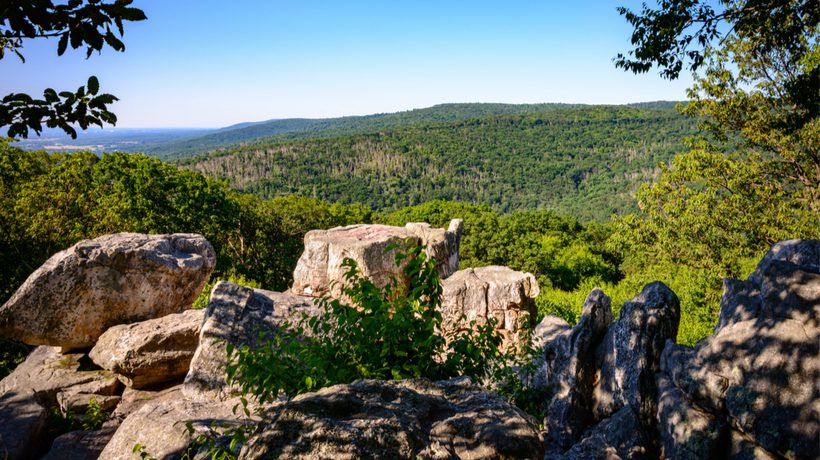
Revel in the splendor of the mountains from scenic vistas and spectacular overlooks at the Catoctin Mountain National Park, a natural mountain oasis surrounded by growing urban areas. It’s a great place to escape the hustle and bustle of city life, as it’s only a short drive from Washington D.C. In the past, Native Americans lived in these mountains, utilizing the resources here for tools, medicine, food and shelter. Later, it suffered the effects of extensive logging to provide charcoal for the iron industry. The lush second growth forests you see today are testament to how resilient the environment has proven. This beautiful area is home to the presidential retreat of Camp David, although visitors are not allowed there for security reasons.
Over 5,000 acres of hardwood forest and meandering streams are a haven for several threatened and endangered species in the state. If you’re lucky, you may see the rare black bear, bobcat, beaver or mink during an afternoon hike. More likely though, you’ll see one of the many squirrels, chipmunks, white-tailed deer, woodpeckers and wild turkey that roam the woods. There are around 200 species of birds, including indigo bunting, scarlet tanager, wood thrush and red-eyed vireo. Most of the park is mixed hardwood forest and presents the ideal environment for the animals that live there and the people who come to enjoy it.
Hike to Chimney Rock or Hog Rock, both over 1,000 feet high, to take in the scenery. There are a range of trails, from easy to strenuous. Pick the one that is best for your skill level and tenacity or ask a park ranger to suggest one. The East Side trails lead to Cunningham Falls, a wonderful spot to snap some nature photos that are sure to impress your friends. Meanwhile, the West Side trails offer the best chance at an up close view of the wildlife. For a little local history, hike the Blue Blazes Whiskey Stills Trail, where a police raid during Prohibition resulted in the death of the deputy sheriff and a mystery involving a love triangle, murder and arson that still has not been solved. The campgrounds and picnic areas also connect with the West Side trails. After an invigorating hike, wade in one of the cool streams.
Big Hunting Creek is the most popular place for fly fishermen. Recreational fishermen will delight in the bountiful brook, brown and rainbow trout that spawn here. You will need a Maryland fishing license and trout stamp, and all trout caught must be released. You can also enjoy six miles of trails that are open for public horseback riding if you have your own horse. The nearest horse rental facility is in Gettysburg, which would require you to trailer the horse to the park. But maybe the most exciting, thrill-enthusiast-friendly activity within the park is rock climbing. Roped rock climbing is available at Wolf Rock, but bouldering is permitted anywhere within the park.
It’s imperative to use caution when taking in the mountain view from one of Catoctin Park’s famous vistas. Jumping and running on top of a mountain are a bad idea. While this might seem like common sense, many people are injured by carelessness at these overlooks. The visible distance between the rocks can be deceiving and attempting to leap from rock to rock commonly ends in bodily harm. A couple more practical tips for your visit: While winter is a good time for skiing along trails or closed roads, you won’t really get to experience these mountains at the peak of their wonder. The rich green of the forest and the babbling of the streams are part of the ambiance that you just won’t see, hear and experience in the winter time. Plus, staying overnight in the park is ideal during warmer months. Cabins are available for rental or you can set up your tent on one of the campgrounds. Roll out of your sleeping bag and wake up to the fresh mountain air!
New River Gorge National Park
West Virginia
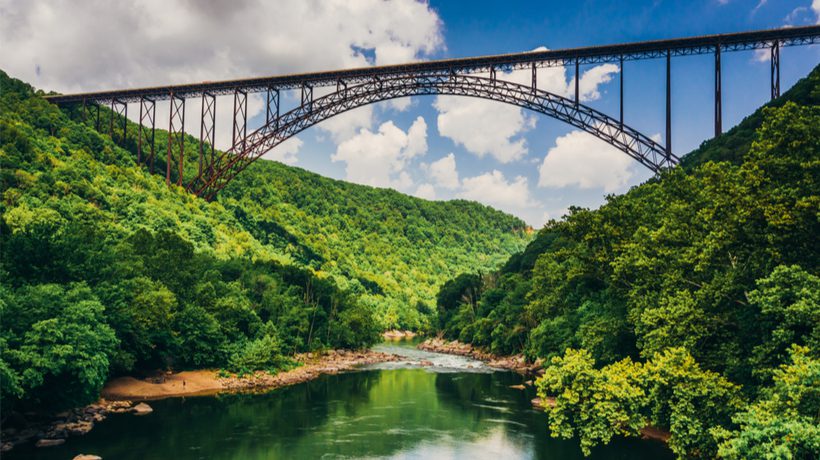
Despite its name, the New River is actually one of the oldest rivers on the planet. Over a million people come to visit this park every year, further proving its awesomeness. There are 70,000 acres to explore and every inch is worth the trip. The river has carved the deepest and longest river gorge in the Appalachian Mountains, making it a truly breathtaking sight. There is plenty of beauty to behold on the hiking trails and there is no lack of additional, non-hiking activities to enjoy. The park is a hub for cycling, climbing, whitewater rafting, camping, birdwatching, fishing, hunting and more.
The New River cuts through the Appalachian Mountains in West Virginia, creating a unique environment with many different ecosystems. The forests and ridges are bursting with wildlife. The endangered Virginia big-eared bat and the Indiana bat can be found here. White-tailed deer, red fox, black vultures, various butterflies, five lined skinks, red fox and black bears are often spotted in the forests and clearings.
The Lower Gorge is one of the best whitewater rafting locations in the U.S. The rapids here range from Class III to Class V difficulty, the latter of which require skillful maneuvering through some of the tricky, powerful river currents. Unless you are a rafting expert, the best way to experience the rapids is by utilizing one of the authorized outfitters from April through October. Traveling down river with a knowledgeable and experienced guide provides safety and confidence as you experience the thrill of the river ride. The water in the park is also full of fish, crayfish and mussels. Fishing is one of the most popular activities and the spring and fall are the peak seasons. There are many walleye, bluegill, carp and catfish, but the smallmouth bass are especially abundant and relatively easy to snag. Consider using live bait if you want the most bass-catching success.
The best place to start is one of the visitor centers. Grab a map and ask the rangers questions about the park and the activities here. The must-see scenic vista at Grandview offers some of the best views of the gorge. Rangers offer weekly bird walks here during the summer and spring. In the summer, swarms of brown bats fly through Grandview. The colorful, huge blossoms of the rhododendrons are a picture-perfect opportunity if you happen to visit during the summer. From Grandview, you can also see the rail yards where coal was shipped and timber was transported through the area in the past. Visit Thurmond, a once booming coal town that’s now more of ghost town, and learn about the early pioneers and workers who lived and died here and New River Park’s cultural and historical significance.
The National Parks service states that The New River Gorge Bridge is one of the most photographed places in West Virginia. It is a beautiful spot that deserves its place on the National Register of Historic Places. The view from the top of the bridge is spectacular all year long. If you like the energy of crowds and special events, then the third Saturday of October is perfect as you can celebrate Bridge Day. It’s the largest festival in West Virginia and draws thousands of thrill seekers to enjoy BASE jumping, rappelling and other extreme sports. Other park events include the Haunted History Hike and the Red Ash Hike and Bike ranger-led bike tour just before Halloween, the Spring Nature Fling around April or May, Hidden History Weekend in late September and Thurmond Train Day in mid-July.The park is ideal for the adrenaline junkie with its rapids, climbing and BASE jumping but is also a perfect place for a peaceful, restful day enjoying nature’s finest rugged beauty.
Another photo-worthy spot is Sandstone Falls, the largest waterfall in the park. It is quite a drive and a hike to catch sight of these cascading waters, but well worth the effort. Begin your walk at the Sandstone Falls day use area and continue along the boardwalk and across the two bridges that span the two islands below falls. You may catch sight of bald eagles, blue herons or osprey. In the winter, beavers, minks, river otters and muskrats scamper about the water’s edge and navigate the waters near the falls.
The park also offers over 1,400 established rock climbs and is one of the most popular climbing areas in the U.S. Biking is allowed along certain trails, like the Arrowhead Trails and the Fayetteville Trail. Hunting is another popular sport at this national park. If it is your first time hunting here, be sure to educate yourself on the hunting rules and regulations. During spring and fall, fishing in the park is ideal, with bass (smallmouth, largemouth, striped, and rock), walleye, muskellunge, crappie, bluegill, carp, or flathead and channel catfish available throughout the river.
East South Central Division
Little River Canyon National Preserve
Alabama
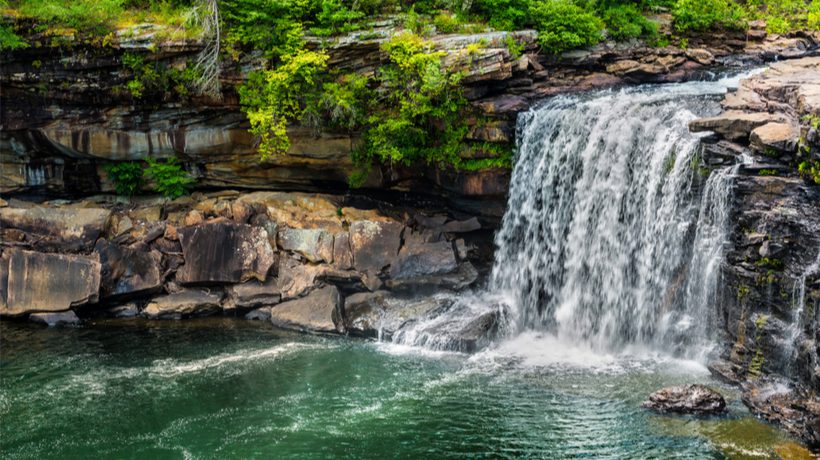
In the Little River Canyon National Reserve, peaceful streams give way to wild rapids, rocky pathways lead to stunning overlooks and waterfalls plunge down into the clear basin of water below. The majority of Little River flows high atop Lookout Mountain in northeast Alabama and features canyons, bluffs, forests, boulders and cliffs. The river supports many different plant and animal species, including some rare species like the endangered green pitcher plant. The special geological and habitat features that mark the landscape set it apart from the picture of Alabama you might have in your mind’s eye. Explore on foot, bike or kayak or even from the comfort of your car. Little River Canyon park will surprise you.
Take a scenic drive along the Little River Canyon Rim Parkway and take photos or picnic at one of the eight overlooks where you have a bird’s eye view of waterfalls, rock formations and lush forest. Don’t miss a visit to the 45-foot waterfall, Little River Falls, which is your first stop when you begin the scenic tour from the north. Use extra caution here, as the rocks can be slippery and treacherous when wet. The current is especially strong and the water level is high after a big rainfall, so it is easy to be swept away.
There are many different trails to hike, from the woody Beaver Pond Trail to the 16-mile DeSoto Scout Trail to the Eberhardt Trail, from which you can venture down the canyon to some popular swimming holes in the summertime. The water in this river is not only pristine and high quality, it also carved the canyon here, which is one of the deepest east of the Mississippi.
Birdwatch and hike anywhere in the preserve. The skies and branches are full of a variety of birds from raptors to songbirds. For those with Alabama licenses and permits, fishing in the river and hunting in the surrounding area might add some extra hours of fun. Canyon Mouth Park is a popular fly fishing destination where anglers can catch redeye bass. Rock climbing is allowed on any of the cliffs for those confident and prepared with their own gear and climbing equipment. Horseback riding and mountain biking in the backcountry are other activities visitors can partake in here.
The park is particularly beautiful during the fall when the rich colors paint the forest and truly capture the crisp feeling of autumn. It’s picture-perfect ready for aspiring nature photographers. Another fabulous time to visit is during the spring after a refreshing rainfall. You will be surprised how verdant, lush and changed this landscape looks after a heavy rain. The whole forest seems alive and renewed. Convenient parking at the Canyon Mouth Park makes access to the river easy. You’ll also find picnic tables, grills and restrooms here. Leashed pets are welcome within the preserve, as long as you dispose of their waste responsibly. If you plan on staying in the area for a while, consider visiting the nearby Desoto State Park which offers lodging like camping, cabins and chalets.
Mammoth Cave National Park
Kentucky

Did you know the world’s longest known cave system is in Kentucky? More than 400 miles of caves have been explored, making Mammoth Cave National Park more than worthy of its name. In addition to being a national park, it is also a UNESCO World Heritage Site and International Biosphere Reserve. Experience the underground wonder firsthand during one of the many cave tours before going on to explore above ground. The first priority and the absolute best way to experience the unique geology here: cave tours. It’s believed that 4,000 years ago people first entered these caves to explore the unknown. Curiosity also led early European settlers underground towards the end of the 18th century. Today, humans are still exploring the Mammoth cave system. Ranger-led cave tours vary by the season and tickets are required to enter. Reservations are your best bet for ensuring a spot. Plan ahead so you don’t miss out on the adventure of a lifetime, especially during the busy months, when tours can fill up quickly .
You might want to bring along a light jacket for your trip below because the caves can get chilly. There is a selection of accessible and non-strenuous ways to see Mammoth Cave. The Mammoth Passage Tour will take you into one of the largest spaces in the cave for an educational introduction and a short talk on the cave features, all with little physical effort. If you’re looking for some more exercise and education, The Grand Avenue Tour, a four-hour excursion through some of the cave’s complex passages, narrow canyons and large rooms, involves over 200 stairs. Some other tours utilize elevators for entering and exiting the system. Ask a park ranger for the full list of tour options to determine which one is the best for you and your group. While admission to the park is free, the cave tours do have fees.
Once you have explored the caves, there is still plenty to do. Biking, horseback riding, angling, camping and hiking are all within reach once you exit the caves. Rent a canoe or kayak from one of the local outfitters and paddle on the Green River or Nolin River and see if you can spot some of the local wildlife like wild turkey or white-tailed deer. Fish for bluegill, catfish, perch and bass or bike along any of the paved roads in the park. Due to the swift current, swimming, tubing and rafting are not allowed. There are even specially designed off-road trails for mountain bikers to catch some air and build their skill. Horseback ride through the 60 miles of permitted trails or bring your binoculars for some birdwatching.
You can stay right in Mammoth Cave National Park at the Lodge of Mammoth Cave conveniently located near the visitor center, which has both modern hotel rooms and historic woodland cottages. Even if you aren’t staying at the lodge, you can take advantage of the two restaurants that operate in season, on site. If you would rather eat under the sky, then picnic anywhere in the park, including the three developed campgrounds and many primitive camping sites. Some campsites can even be reserved online, so you can plan ahead for your cave vacation. Partake in family camping under the stars or a couples’ getaway in one of the cottages. Be sure to look up at night, since Mammoth has been designated an International Dark Sky Park, making it one of the best places on the planet to stargaze. There is even a ranger-led stargazing program where the rangers can help you can identify planets, the International Space Station (if the time is right) and other spectacular heavenly bodies through the park’s telescopes.
Gulf Islands National Seashore
Mississippi and Florida

While you may not think of Mississippi when planning a beach vacation, this Mississippi seashore might surprise you. These islands off the coast of Mississippi and Florida allow visitors to revel in turquoise waters and pristine and uncrowded white sand beaches. This area stretches from Cat Island in Mississippi for 160 miles to Fort Walton Beach, Florida. Sail away and escape to your own personal island of solitude to enjoy swimming, snorkeling, fishing and picnicking.
Most of the islands here are only accessible by private boat. If you love open space and open water, Cat Island might be the perfect place to bring out your boat for a day of wildlife viewing or birdwatching. The island is just one of the 12 areas within this national seashore — and some of the best are in Mississippi. Beautiful beaches and fertile coastal marshes offer a range of places to see and things to do for your dose of sunshine and sea.
Most of the islands are only accessible through private boat or charter, however the National Parks System offers a ferry for transportation to Ship Island March-October, departing from Gulfport, Mississippi. If you plan on taking a boat out for the day, then a 20-foot or longer craft is recommended. Follow safe boating practices and bring along an up-to-date nautical chart to help you navigate. In the Florida part of the park, the Okaloosa Day Use Area is accessible by car and has gorgeous sandy beaches, calm water for swimming, a picnic area and public restrooms. Perdido Key is considered to be one of the most beautiful beaches in the country and is also a great destination for bird watchers. If you need to stretch out your sea legs, the 15-mile Live Oaks Bicycle Route loop is a great option.
Stay the night at the Davis Bayou Campground, which has 50 sites for RVs and tents, or stay at one of the stunning beachfront hotels in nearby Gulfport, Mississippi. Primitive camping is available on Cat Island, East Ship Island, Horn and Petit Bois Island. All of these islands are quiet and secluded, as they can only be reached by private boat. Horn and Petit Island, for instance, are official wilderness zones and ideal for viewing the water, air and island life. These undeveloped barrier islands are an untouched tropical oasis. You won’t find restrooms, buildings or structures of any type in these primitive areas. If you’re searching for amenities, try West Ship Island, which has a swimming beach and picnic pavilions. Before you tuck in for the night, take a moment to appreciate the stars. The night skies are absolutely stunning; you will be far from light pollution so you will see many more stars than you thought possible.
Depending on the day you visit, you might also be able to take advantage of one of the ranger-led activities. Slide your kayak into the water for Kayaking 101, the perfect chance to paddle beside a park ranger to learn more about the habitats and unique environmental factors in the Gulf Islands National Seashore, or join the Gator Walk to spot these impressive predators in the Davis Bayou Area. There are also several commercial boat tour services available in the area.
There are a variety of watersports available, from boating charters, kayaking or paddle boarding to swimming, snorkeling and diving. Enjoy recreational fishing from boat or shore with your Mississippi State Saltwater Fishing License. Or if you prefer hunting, waterfowl hunting is allowed in the national seashore in certain areas on the Florida side of the park. A Florida hunting license, waterfowl permit, migratory bird permit and federal duck stamp are required.
Great Smoky Mountains National Park
Tennessee and North Carolina
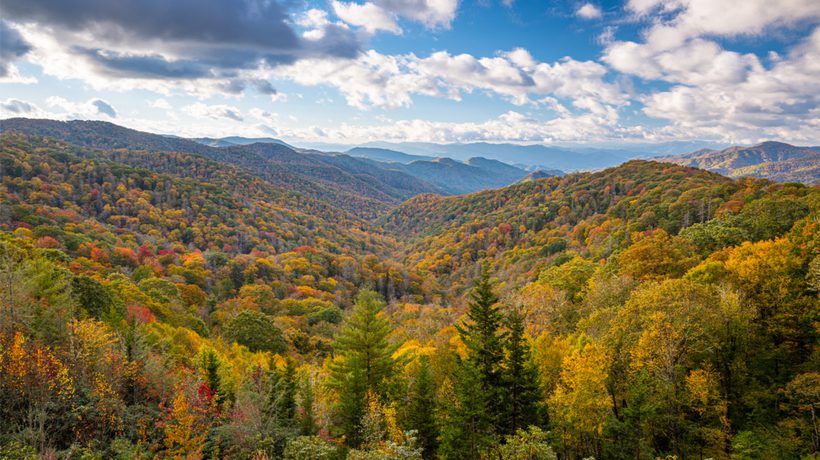
The Great Smoky Mountains National Park is the most visited in the country, and with good reason. There are breathtaking mountains, crystal clear streams, cascading waterfalls and an abundance of plants and wildlife, which can be experienced on the bountiful trails, on bicycle or by car. A seemingly endless sea of green forest is home to one of the nation’s largest protected areas for black bears in the wild. An estimated 1,500 bears live in the park and many visitors catch sight of them during their visit. Huge and powerful, some Smoky Mountain bears weigh over 600 pounds! The lush valley of Cades Cove is also one of the most popular destinations in the park for its wildlife viewing: white-tailed deer, coyote and turkey are among some of the species you may see. Interspersed among the natural beauty, you can see man made structures from the 1800s and later such as churches, barns, log homes and a working grist mill.
The area is overflowing with life of every sort. More than 1,500 species of flowering plants grow here. Sometimes called “Wildflower National Park,” there are more flowering plants here than any other national park. Early spring brings the ephemerals which only flower in a brief, two-month window such as trillium, multiple orchids, bleeding heart, fire pink and violets. However, there are species of wildflowers that bloom year-round in the park. A wildflower walk along a suggested route will take you through the heart of the colorful blossoms. The best and most popular way to see and experience the beauty of this park is on one of the many hiking trails.
This is a hikers’ paradise any time of the year with many popular trails to explore. A great place to start your mountain adventure is Cades Cove, where the Cherokee Indians hunted for centuries. Here you will find an 11-mile road for auto touring, many hiking trails and even a two-hour hayride for the young and the young at heart. The Rainbow Falls trail, while a bit strenuous, takes you past wildflowers, across bridges and up to the spectacular 80-foot waterfall. Take a steep climb on the Chimney Tops trail up to the summit to take in the gorgeous view from the top of the ridge. If you have children and want a hike that is appropriate for them, try the Porters Creek Trail, a two mile round trip hike where you can see the remnants of 18th and 19th century communities along with wooded areas, rushing streams and carpets of wildflowers.
This national park is prime for an extended mountain vacation with family or friends. The surrounding areas are full of quaint bed and breakfasts, hotels and authentic log cabins. There are many local attractions, stores and restaurants to visit outside of the park. But there is more than enough to enjoy within the Great Smoky Mountains National Park for many days of outdoor fun and entertainment. A popular summer destination, children and families will enjoy splashing in the cool streams during the summer’s heat. There are many waterfalls in the park and all of the streams are open for fishing with a North Carolina or Tennessee fishing permit. Trout and smallmouth bass are especially plentiful. Families may also enjoy a guided horseback riding tour, which is available in Cades Cove during the warmer months. Entrance to the park is free but horseback riding, hayrides and equipment rentals do incur fees.
West South Central Division
Chickasaw National Recreation Area
Oklahoma
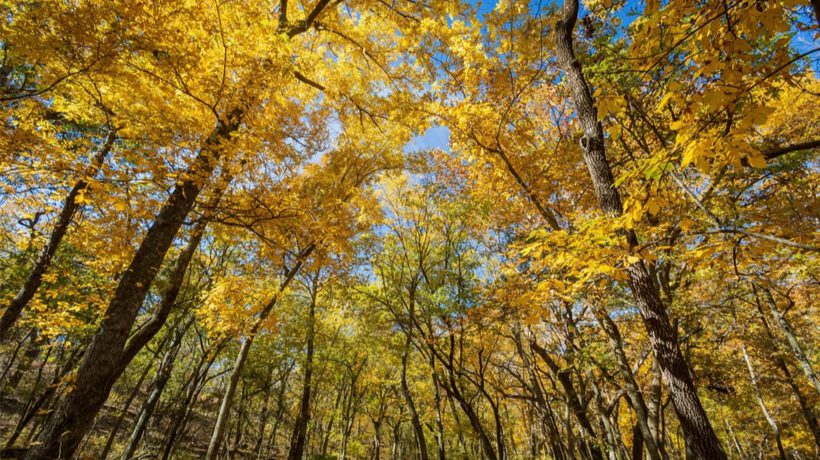
A mental picture of Oklahoma might call to mind flat endless plains and grasses. At Chickasaw National, a picture of lush green forests, lake vistas and babbling brooks is much more fitting. While this area may not draw the crowds and visitors from other states like some of the other national parks, it is a wonderful place for recreation for Oklahoma residents and those willing to take the trip.
The streams, lakes and springs here provide fishing, boating and swimming opportunities galore. The ice cold water is especially invigorating during the summertime. Fishing in Veterans Lake or wading in the swimming holes of Little Niagara and Rock Creek are some popular ways to spend the afternoon. Fish in the great outdoors, but be sure to bring your state fishing license. Take advantage of the populations of white bass, sunfish, largemouth bass and catfish that swim in these waters. Lake of the Arbuckles is a great place for boating, fishing and swimming. The lake also includes four launch ramps, making it easy access for your boat. Sailboats, motorboats and canoes all share the water here. The park’s Veterans Lake is set aside for no wake boats, like canoes, and also features wheelchair accessible docks for fishing. You can also take in the water’s beauty from one of the trails. Many visitors run along the water’s edge, occasionally offering a view of beavers building their dams, deer lapping at the water or waterfowl bobbing on the surface. You can hunt for ducks, geese, rabbits, turkey, quail and deer here in season. If hunting, familiarize yourself with hunting laws, rules and regulations before you go.
Cycle down the Platt Historic District trail, a paved loop road with numerous trails branching out, letting the fresh air fill your lungs and lift your spirits. Ride horseback along the Rock Creek trail and birdwatch all throughout the park. The diverse ecosystem supports a wide range of species. Ranger led programs provide an education about this transition zone between deciduous forest and Western prairies.
A relatively new addition to Chickasaw is the Platt National Park, an adjacent area that the Chickasaw Nation sold to the government to protect its freshwater and mineral springs from exploitation. In the 18th and 19th centuries, visiting mineral springs was seen as being therapeutic and the area was being overrun with visitors. As part of the New Deal, the Civilian Conservation Corps built mineral spring pavilions, picnic areas, dams and waterfalls, all connected with a network of trails and rewilded with more than half a million trees and shrubs. Unlike at the nearby Hot Springs, the mineral springs water at Chickasaw is cold and refreshing, and suitable for either drinking or bathing.
In inclement weather, escape indoors to the Travertine Nature Center to see the live reptiles, exhibits, birds of prey and educational videos. Children may enjoy the interactive learning area while parents browse brochures, maps and guides at the information desk. A place for your tent or RV can be reserved ahead of time if you plan to stay the night. And don’t miss the serene sunset over Veterans Lake after you finish setting up camp at one of the six campgrounds.
Hot Springs National Park
Arkansas
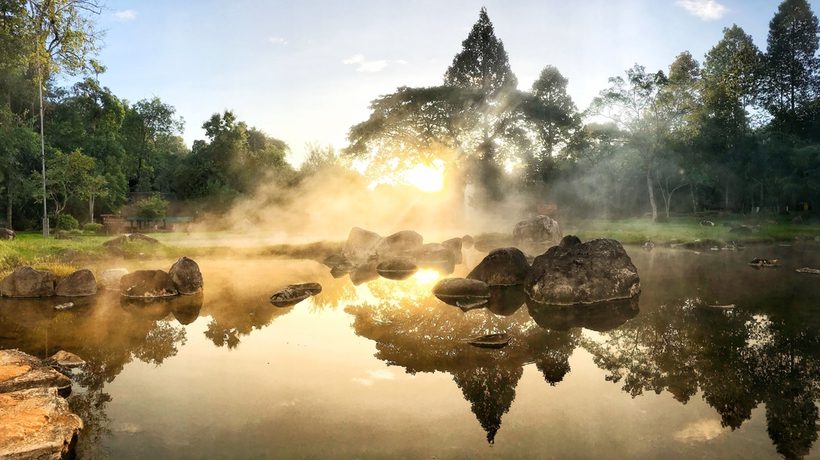
Hot Springs National Park is one of the few national parks that is located in a town. It is surrounded by shops, roads, restaurants and other buildings. Take a dip in Arkansas’ famous, soothing hot springs. People have been visiting the baths here for hundreds of years to relax in the 143-degree Fahrenheit water. The hot springs here occur naturally and emerge along a fault line beside Hot Springs Mountain. Come see, learn and even taste the rich history. The town of Hot Springs grew up around these springs, which drew crowds of tourists who wished to experience “America’s Spa.” The earliest bathhouses here were simple, almost primitive huts that offered little in the way of luxury. But soon modern facilities emerged and experienced heavy traffic from 1880 to 1950. Visit the historic Fordyce Bathhouse to see what one of these elaborate spa facilities was like during the peak of the Golden Age of Bathing. This building is beautiful, full of decadent marble and stained glass. The perfect first stop for your visit, it also serves as the visitor center for the park. Here you can watch a movie about the spa’s history, ask about guided tours and obtain information about attractions in the area.
Then, explore Bathhouse Row, and its eight bathhouse buildings constructed between 1892 and 1923. Take a cell phone tour of Bathhouse Row to learn about the history of each bathhouse and each one’s unique architecture and decorative features. Visitors 11 years or older can take a traditional bath at the Buckstaff Bathhouse in one of the European style individual tubs. A local staple, the bathhouse has been providing services since 1912. The Lamar Bathhouse offered marbled bathtubs in various lengths, while the Ozark Bathhouse features sculpted mythical creatures holding urns of water. The Hale Bathhouse has a sauna in a thermal cave carved into the mountainside. If you prefer a more rustic experience, you can walk down to the Display Spring behind the Maurice Bathhouse or the Hot Water Cascade at Arlington Lawn to see and touch the thermal water as it naturally occurs, but bathing in the outside springs is not allowed.
Aside from its bathing and spa use, the water is of excellent drinking quality. Most visitors taste the water during their visit and often fill bottles at one of the thermal spring fountains throughout the park to take with them. Bring a bottle with you for a walk down the Grand Promenade or a hike to the Mountain Tower. For a small, individual fee you can travel to the top of the tower to overlook 140 miles from a height of 1,256 feet. You can also pick up a snack or souvenir at the gift shop while you’re there.
There are 26 miles of hiking trails within the park, giving you a good dose of forest-fresh air to go along with the thermal water. The Hot Springs and North Mountain trails are the most popular since they are easy to get to and provide beautiful scenery. If you are on the lookout for wildlife, take the West Mountain Trails, where you may catch a glimpse of a black bear, deer, falcon or golden-crowned Kinglet.
Another great way to take in the scenery is by driving one of the mountain roads or taking one of the outdoor guided tours that are offered during the summer. The Gulpha Gorge Campground offers tent and RV sites within the park. But the campground is first come, first served and no reservations are taken, so arrive early to secure your spot. There are restroom facilities but no showers available. One other place of interest is the nearby Quapaw Baths and Spa. The modern facilities here are the most luxurious way to indulge in the hot springs. Soak in a hot spring pool or enjoy one of the various spa services. Facials, body treatments and hot stone massages are some of the many offerings here. The town of Hot Springs has fun and interesting events throughout the year, including foodie events like FeastMonth in Hot Springs, fitness events like the Iron Ranger Challenge and musical events like a tribute to the Blues Brothers.
Big Bend National Park
Texas
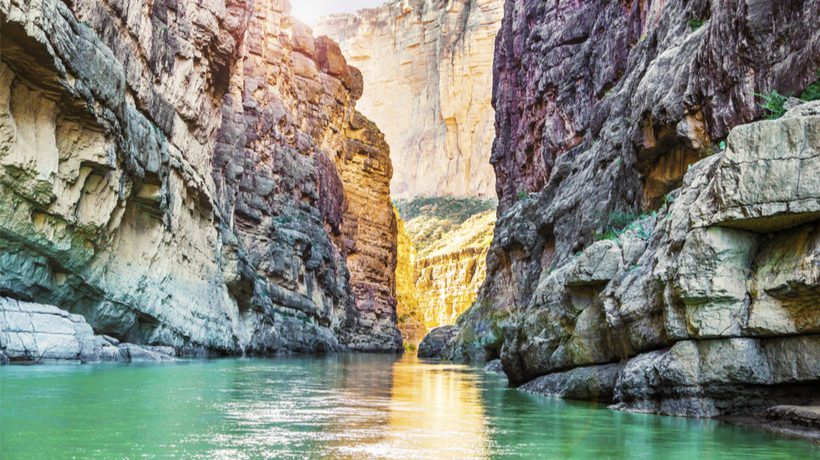
For a taste of what Texas looked like to the early settlers, take a trip to Big Bend, an area that is touted as being one of the few last wild corners of the U.S. This untouched park has desert, canyons, mountains and water for a truly unique experience. Take part in horseback riding, hiking and paddling down the river by the day. Or, by night, enjoy stargazing and camping in the national park with the least light pollution. Over 150 miles of trails and innumerable backcountry areas to explore make this park a hiker’s dream come true. Spend a couple of hours on an easy day hike or take on some of the more strenuous paths. Big Bend is also a great place for a serious backpacking adventure. Big changes in elevation produce temperature differences and provide a variety of different plant and animal life between the low and high elevation areas. Hike through the vast desert environment to see cacti and termite nests. Over 80 percent of the park is Chihuahuan desert, but the spring brings many different plant species and wildflowers to life under the often intense Texas sunshine. Panther Path offers a wheelchair accessible loop through a desert garden with numbered stops and an educational brochure about the plants and their uses.
Gorgeous vistas can be accessed by car, foot and even bike. The strenuous, steep trip from Panther Junction to Chisos Basin Junction offers an exhilarating downhill ride for cyclists, while other routes are a little easier on the legs. The park even offers visitors with a valid passport a convenient way to visit Mexico through Boquillas Crossing Port of Entry (although this is closed at least until November 17, 2021). Additionally, there are over 100 miles of paved roads to cruise down and take in the unique natural environment. Those with a four-wheel drive vehicle can explore the dirt roads of Old Maverick Road or the even more primitive dirt roads that cross canyons and creek beds in the more remote areas of the park.
Stop by the Fossil Discovery Exhibit to see some of the ancient fossil specimens that have been found here in the limestone and surrounding areas. Learn about the wildlife past and present. Hundreds of species of birds and many reptiles, amphibians, fish and mammals call Big Bend home. Birdwatching through the mountains and deserts is a popular park hobby. See some of the park’s other creatures on a river, mountain or desert hike.
Choose your experience: a desert, mountain or river hike. Journey above the desert for 20 miles of Chisos Mountain trails. A trip down Boot Canyon Trail takes you through the lushest part of the mountain environment and offers a look at the Arizona Cypress trees that are only found in this part of the national park. Black bears and mountain lions live in these mountains, but it’s unlikely to see one. More common sightings include some of the rock squirrels, whiptail lizards and Mexican jays. From high above, take in the majestic Rio Grande that flows through Big Bend. Hiking trails along and around the river give you an up close view of the river’s ecosystem. The Santa Elena Canyon Trail is one of the popular riverside trails. It crosses a creek, climbs to a beautiful vista and then down again to the river’s edge, making it perhaps the best way to experience the river. There are boating outfitters within the park that offer gear, equipment and many half- or full-day river excursions.
There are several ranger-led programs including a range of guided walks, talks about the animals that make the park their home and more. A visit to the Castolon area can acquaint you with the history of the region (the Castolon Historic District is listed on the National Register of Historic Places) and you can grab a snack at the historic La Harmonia store.
With a wealth of natural splendor, it is no wonder that this park’s popularity is on the rise. An increase in visits, especially during national holidays and busy holiday breaks, make it best to plan ahead in regards to lodging and activities within the park. Big Bend is perfect for a multi-day vacation. Make plans for lodging in the park, especially during the popular times, such as summer, weekends and holidays. Campgrounds and The Chisos Mountains Lodge are often full to capacity during these times. The lodge offers a restaurant and gift shop, as well as a variety of rooms and cottage options for any size group. There are also three campgrounds with restroom facilities within the park. Many of the sites are first come, first served, so arrive early. Parking within Big Bend National Park can also pose some difficulty. Patience is necessary while you search for an available spot. Or make it to the park in the early morning to take advantage of the best parking opportunities. You’ll be rewarded with the best chance of bird sightings, as they are most active during the start of the day.
Late fall through early spring is the best time to visit Big Bend; if visiting in the summer, be prepared for the heat with cool clothing, hats and plenty of water and plan to do your hiking in the early morning or evening when it is cooler. When in the park, make sure you have a park map since cell phone service is spotty.



